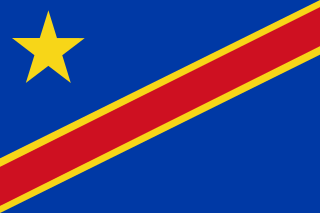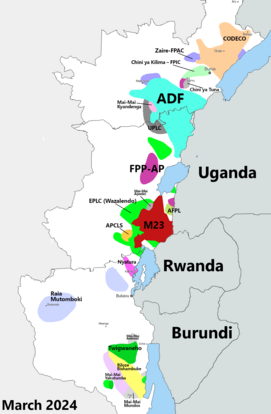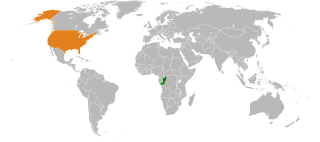Related Research Articles
The Armed Forces of the Republic of the Congo, also less formally denoted as the Forces armées congolaises or its acronym FAC, are the military forces of the Republic of the Congo. They consist of the Congolese Army, the Congolese Air Force, the Congolese Marine (Navy), and the Congolese National Gendarmerie. The dissolution of French Equatorial Africa in 1958, and France's impending military withdrawal from the Congo in August 1960, provided the impetuous for the formation of the FAC. The FAC and state paramilitary agencies are headed by an Armed Forces Chief of General Staff, usually appointed by the President of the Republic of the Congo. Major General Guy Blanchard Okoï has served as chief of staff since 2012.

Patrice Émery Lumumba was a Congolese politician and independence leader who served as the first Prime Minister of the independent Democratic Republic of the Congo from June until September 1960. He played a significant role in the transformation of the Congo from a colony of Belgium into an independent republic. Ideologically an African nationalist and pan-Africanist, he led the Congolese National Movement (MNC) party from 1958 until he was assassinated.

The Belgian Congo was a Belgian colony in Central Africa from 1908 until independence in 1960. The former colony adopted its present name, the Democratic Republic of the Congo (DRC), in 1964.

The Democratic Republic of the Congo, also known as Congo-Kinshasa, DR Congo, the DRC, the DROC, or the Congo, and formerly Zaire, is a country in Central Africa. It is, by area, the largest country in sub-Saharan Africa, the second-largest in all of Africa, and the 11th-largest in the world. With a population of around 92 million, the Democratic Republic of the Congo is the most populous officially Francophone country in the world, as well as the fourth-most populous country in Africa and the 15th-most populous country in the world. It is a member of the United Nations, Non-Aligned Movement, African Union, and COMESA. Since 2015, the Eastern DR Congo has been the site of an ongoing military conflict in Kivu. The capital and largest city is Kinshasa.
Music of the Democratic Republic of the Congo varies in its different forms. Outside Africa, most music from the Democratic Republic of Congo is called Soukous, which most accurately refers instead to a dance popular in the late 1960s. The term rumba or rock-rumba is also used generically to refer to Congolese music, though neither is precise nor accurately descriptive.
Soukous is a genre of dance music from Congo-Kinshasa and Congo-Brazzaville. It derived from Congolese rumba in the 1960s and gained popularity in the 1980s in France. Although often used by journalists as a synonym for Congolese rumba, both the music and dance associated with soukous differ from more traditional rumba, especially in its higher tempo, longer dance sequences. Notable performers of the genre include African Fiesta, Papa Wemba and Pépé Kallé.

The Congo Crisis was a period of political upheaval and conflict in the Republic of the Congo between 1960 and 1965. The crisis began almost immediately after the Congo became independent from Belgium and ended, unofficially, with the entire country under the rule of Joseph-Désiré Mobutu. Constituting a series of civil wars, the Congo Crisis was also a proxy conflict in the Cold War, in which the Soviet Union and the United States supported opposing factions. Around 100,000 people are believed to have been killed during the crisis.

The culture of the Democratic Republic of the Congo is extremely diverse, reflecting the great diversity and different customs which exist in the country. Congolese culture combines the influence of tradition to the region, but also combines influences from abroad which arrived during the era of colonization and has continued to have a strong influence, without destroying the individuality of many tribal' customs.
Congolese rumba, also known as Rumba Lingala after its predominant language, is a popular genre of dance music which originated in the Congo basin during the 1940s, deriving from Cuban son. The style gained popularity throughout Africa during the 1960s and 1970s.

The Congolese Association Football Federation is the governing body of football in the Democratic Republic of the Congo. It was founded in 1919 and affiliated to the FIFA in 1964 and CAF in 1964. It organizes the national football league Linafoot and the national team.

The Republic of the Congo was a sovereign state in Central Africa, created with the independence of the Belgian Congo in 1960. From 1960 to 1966, the country was also known as Congo-Léopoldville to distinguish it from its northwestern neighbor, which is also called the Republic of the Congo, alternatively known as "Congo-Brazzaville". In 1964, the state's official name was changed to the Democratic Republic of the Congo, but the two countries continued to be distinguished by their capitals; with the renaming of Léopoldville as Kinshasa in 1966, it became also known as Congo-Kinshasa. After Joseph Désiré Mobutu, later Mobutu Sese Seko, commander-in-chief of the national army, seized control of the country, it became the Republic of Zaire in 1971. It would again become the Democratic Republic of the Congo in 1997. The period between 1960 and 1965 is referred to as the First Congolese Republic.

The Kivu conflict began in 2004 in the eastern Congo as an armed conflict between the military of the Democratic Republic of the Congo (FARDC) and the Hutu Power group Democratic Forces for the Liberation of Rwanda (FDLR) in the Democratic Republic of the Congo. It has broadly consisted of three phases, the third of which is an ongoing conflict. Prior to March 2009, the main combatant group against the FARDC was the National Congress for the Defence of the People (CNDP). Following the cessation of hostilities between these two forces, rebel Tutsi forces, formerly under the command of Laurent Nkunda, became the dominant opposition to the government forces.

Republic of the Congo–United States relations are the international relations between the Republic of the Congo and the United States of America.
The Zaire Use, officially the Roman Missal for the Dioceses of Zaire, is a Congolese-based variant use of the Roman Rite within the Catholic Church. Approved by the Vatican in 1988, it contains many elements from the Ordinary Form of the Roman Rite, but also incorporates elements from sub-Saharan African culture, particularly Congolese, including a number of inculturated liturgical modifications.
Congolese Americans are an ethnic group of Americans of descent from the Democratic Republic of the Congo (DRC) and the Republic of the Congo.

The Simba rebellion of 1963–65, also known as the Orientale Revolt, was a rebellion in the Democratic Republic of the Congo which took place within the wider context of the Congo Crisis and the Cold War. The rebellion, located in the east of the country, was led by the followers of Patrice Lumumba, who had been ousted from power in 1960 by Joseph Kasa-Vubu and Joseph-Désiré Mobutu and subsequently killed in January 1961 in Katanga. The rebellion was contemporaneous with the Kwilu Rebellion led by fellow Lumumbist Pierre Mulele in central Congo.

Congolese nationalism in the Democratic Republic of the Congo was also for a time known as Zairian nationalism during the rule of Mobutu Sese Seko. Congolese nationalism persists among the people of the Democratic Republic of the Congo, in spite of civil war and the lack of a clear definition of what it means to be Congolese.

The Allied Democratic Forces insurgency is an ongoing conflict waged by the Allied Democratic Forces in Uganda and the Democratic Republic of the Congo, against the governments of those two countries and the MONUSCO. The insurgency began in 1996, intensifying in 2013, resulting in hundreds of deaths. The ADF is known to currently control a number of hidden camps which are home to about 2,000 people; in these camps, the ADF operates as proto-state with "an internal security service, a prison, health clinics, and an orphanage" as well as schools for boys and girls.

The Embassy of the Democratic Republic of the Congo in London is the diplomatic mission of the Democratic Republic of the Congo in the United Kingdom. The embassy was formerly located on Grays Inn Road in Kings Cross.
The Military ranks of Republic of the Congo are the military insignia used by the Armed Forces of the Republic of the Congo. Being a former colony of France, Republic of the Congo shares a rank structure similar to that of France.
References
- ↑ Bazenguissa-Ganga, Rémy. Les voies du politique au Congo: essai de sociologie historique . Paris: Karthala, 1997. p. 425